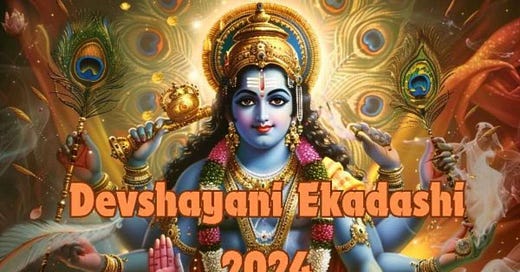Devshayani Ekadashi: Significance and Rituals
Devshayani Ekadashi, also known as Ashadi Ekadashi or Padma Ekadashi, is a highly significant Hindu festival observed on the 11th day of the bright fortnight (Shukla Paksha) in the month of Ashadha.
Introduction
Devshayani Ekadashi, also known as Ashadi Ekadashi or Padma Ekadashi, is a highly significant Hindu festival observed on the 11th day of the bright fortnight (Shukla Paksha) in the month of Ashadha (June-July). It falls on July 17 this year. This auspicious day holds immense spiritual importance for devotees of Lord Vishnu. Here are the key aspects of Devshayani Ekadashi's significance:
Beginning of Chaturmas
Devshayani Ekadashi marks the beginning of the Chaturmas period, a holy four-month span in the Hindu calendar that coincides with the rainy season. During this time, Lord Vishnu is believed to enter a state of Yoga Nidra (divine cosmic sleep) and rest in Ksheer Sagar (the cosmic ocean of milk) on the serpent Shesha. Devotees observe spiritual practices and refrain from certain activities during Chaturmas.
Fasting and Prayers
On Devshayani Ekadashi, devotees observe a strict fast, abstaining from grains, certain vegetables, and specific food items. The fast is dedicated to Lord Vishnu, seeking his blessings. Devotees spend the day in prayer, meditation, and performing puja rituals to honor Lord Vishnu. Chanting mantras like the Vishnu Sahasranama and offering flowers, fruits, and sweets to the deity are common practices.
Spiritual Significance
Observing the Devshayani Ekadashi fast is believed to bestow numerous spiritual benefits. It is said to help devotees attain Moksha (liberation from the cycle of birth and death), relief from past sins and sufferings, and a place in Vaikuntha Dham, the abode of Lord Vishnu. The fast is considered highly meritorious and spiritually purifying.
Rituals and Practices
On Devshayani Ekadashi, devotees wake up early, take a holy bath, and set up an altar with an idol or image of Lord Vishnu. They offer prayers, light lamps, and present offerings like flowers, fruits, and sweets to the deity. Reciting the Vishnu Sahasranama, chanting mantras, and engaging in devotional singing are common practices. Acts of charity and donating essentials to the needy are also encouraged on this day.
Breaking the Fast (Parana)
The Devshayani Ekadashi fast is typically broken on the next day, Dwadashi Tithi, during the specified Parana time. Devotees offer prayers to Lord Vishnu before ending their fast. The fasting items offered to the deity are then donated to Brahmins
Celebrations in Pandharpur
Devshayani Ekadashi is celebrated with great zeal and fervor in the state of Maharashtra, particularly in the town of Pandharpur. The festival is closely associated with the famous Vitthal Temple (also known as Vithoba Temple) located in Pandharpur. The Vitthal Temple in Pandharpur is a highly revered historical temple dedicated to Lord Vitthal, a manifestation of Lord Vishnu. On Devshayani Ekadashi, devotees from across Maharashtra and neighboring states throng the temple to offer prayers and seek blessings. The temple is beautifully decorated for the occasion, resonating with devotional hymns and chants, creating a serene and spiritual atmosphere. The Chief Minister of Maharashtra, Eknath Shinde, also participated in the Pandharpur Wari Yatra this year and offered prayers at the temple on Devshayani Ekadashi, while Union Minister Nitin Gadkari offered prayers at Shree Vitthal Mandir in RK Puram area of Delhi (video).
Pandharpur Wari Yatra
One of the most significant aspects of Devshayani Ekadashi celebrations in Pandharpur is the culmination of the Pandharpur Wari Yatra, an annual pilgrimage that attracts millions of devotees. The Wari Yatra involves carrying the padukas (footwear) of saints, most notably Sant Dnyaneshwar and Sant Tukaram, in a palki (palanquin) from their respective shrines to the Vitthal Temple in Pandharpur. The tradition of the Pandharpur Wari Yatra is believed to be over 700-800 years old. Devotees, known as Warkaris, walk around 250 km from Alandi (near Pune) to Pandharpur, singing devotional songs and chanting the names of Lord Vitthal. The yatra concludes on Devshayani Ekadashi, with devotees taking a holy dip in the Bhima River before entering the Vitthal Temple to offer prayers. While Devshayani Ekadashi is observed across India, the celebrations at the Vitthal Temple in Pandharpur hold a special significance due to the temple's historical and spiritual importance, as well as the grand culmination of the Pandharpur Wari Yatra on this auspicious day for priests.
In Summary
Devshayani Ekadashi is a sacred occasion that allows devotees to deepen their spiritual connection with Lord Vishnu, seek his blessings, and engage in self-reflection and devotional practices. By observing the fast and following the rituals with sincerity, devotees aim to purify their souls and progress on their spiritual journey.





